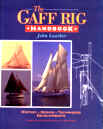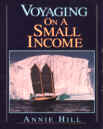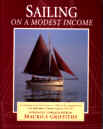|
Book reviews! |
|
The
best books for Getting to Grips with Gaff (rig, that is)
Voyaging/Sailing
on a Small/Modest Income!
The
not-so-dumb Dummies (recommended for use in the US only, folks!)
In Print page
Light Schooner home page
SquareBoats! home page
|
Tom Cunliffe
|
|
If you own a gaff-rigger, or are contemplating building one, or looking to restore one, or are just attracted to the traditional rig, you need this book. Ignore the price tag, just close your eyes when signing your plastic money. The book is a general dissertation on gaff-riggers and the ways of handling them. It does not contain much in the way of "marlin-spike seamanship", and doesn't have as much of the technicalities as you'll find in the next book. But it does contain a great deal of general seamanship and assorted useful information. There are initial chapters on the history of the rig; brief run-downs on gaff rig types from catboats to schooners, their advantages and their shortcomings; chapters on how to equip, including a very balanced set of views on restoration; and chapters on how to handle gaffers in all weathers. The author uses the cutter rig as the primary example. The grounds for this choice are that the catboat and sloop are simpler and therefore covered automatically, and that the ketch, yawl and schooner are multiples of a cutter so you can work out how things apply by a process of addition! It works better than it sounds. The emphasis throughout is on heavy displacement sea-going craft. The author is very scathing about light-displacement fin-keelers but if you're a light schooner fan don't let it worry you. It's easy to spot what applies directly to light gaffers and what is strictly in the realm of heavy sea-going workboats. The book is
well worth buying just for the brilliant chapters on making the rig
work. The explanations and guidelines are the best we've come across
anywhere. Now it can be told - these are the lessons we put into
practice on Flying Tadpole II, and converted into silverware, and this is the book we snuck them
from! So ignore the
price tag - you need this book :) |
|
John Leather
|
|
John Leather's expanded revision of his earlier Gaff Rig has a much more textbooky feel than Hand Reef and Steer -- as well it might, being the best technical reference currently available. The information content is higher in the Gaff Rig Handbook. The text uses clear, plain English, with a lot to ponder on each page. It's loaded with with extensive and detailed line drawings showing rigging details, approaches to gaff sail making, and varieties of sail layouts and hull profiles. Photographs are frequent, large, clear and carefully chosen to illustrate points made in the text. Individual rigs are treated in detail, including rigs from both sides of the Atlantic (and not just the US and UK, either). Really, you need this book for the technical side and Hand Reef and Steer for the sailing. So which one? we have both on our shelf....look at it this way, you can demand one for Christmas and the other for your birthday! |
|
Annie Hill
|
|
This is a wonderful book. You may never wish to voyage further than your local municipal lily pond, or you may dream of roaming the oceans. Either way, you'll find much sanity and clear thinking about life and living, as well as Annie Hill's sharing of hard-earned experience on a live-aboard, voyaging yacht. And if you think that there's no point in a weekend warrior like yourself getting such a book, think again. The chapters on anchoring, motors, electricity, food and safety alone are worth the investment ( and there are 19 other chapters to entrance and seduce you...). Any person who spends more than the odd hour or two aboard their boat, be it shanty, sail, yacht or whatever, will benefit. |
|
|
A book of a different sort is Maurice Griffith's anthology of 1920s articles. While much of this is sailing from another era, the articles retain a timeless quality as pleasant descriptions at the other end of the scale from the Hill's oceanic voyaging. Articles and stories in Sailing on a Modest Income concern short cruises, coastal hopping, much poking up English rivers in search of comfortable pubs. We've drawn on it in deiscussions on Square Boats, too! For those seeking it, publishers are Waterside Publications Ltd, Waterside House, Falmouth Road, Penryn, Cornwall TR10 8BE, England. ISBN 0-9524679-1-7 |
|
JJ & Peter
Isler |
|
If you're in the US and starting out with sailing on anything larger than a peero, you should find this book really helpful. Granted, it does assume conventional (read Bermudan) rig everywhere, but there's a wealth of information on just about everything else to make up for that oversight! It's a great book to crib from - after twenty years of sailing strange craft, we were able to surreptitiously read up on winches, to which we had had no exposure and about which we knew nothing. Now, when people talk about self-tailing, we know that it's not something people do to lambs, involving big metal implements and large rubber bands... Clearly laid out, easy to read, easy to find things, memory aids, great tips, lotsnlotsnlots of useful stuff, we own our own copy etcetc...so why do we say "just the US"? Because by and large, the rest of the world uses a different system of buoyage. So if you apply the pilotage directions in this book somewhere else in the world, you could end up in dire, dire trouble. Get it fixed in the next edition, please, people? (Oh, and the weather work can be confusing in the southern hemisphere, as the authors themselves point out. Remember that Simpsons episode with the water going the other way in the toilet bowl? Well, so do the wind systems.) |
|In Print page|Light Schooner home page|SquareBoats! home page|






